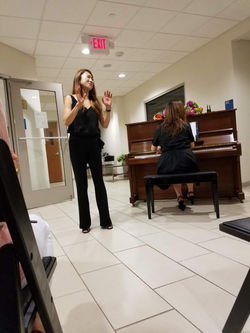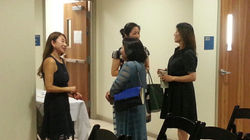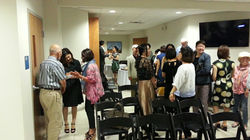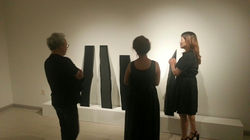 |  |  |  |  |  |
|---|---|---|---|---|---|
 |  |  |  |  |  |
 |  |  |  |  |  |
 |  |  |  |  |  |
 |  |  |  |  |  |
FOR IMMEDIATE RELEASE:
Group Exhibition
Wind: JongSook Kang, Choong Sup Lim, Sungho Choi, Yeong Gill Kim
테나플라이에 위치한 Gallery Yonhee (Korean Community Center 100 Grove Street, Tenafly, NJ)와 Judy Chang 변호사주최, 고수정 큐레이터 기획으로 Group Exhibition 바람 (Wind): 참여 작가 강종숙, 임충섭, 최성호, 김영길 (Jongsook Kang, Choongsup Lim, YeongGill Kim, Sungho Choi) 가 6월 11일 부터 30일 까지 열립니다. 작가와 함께하는 오프닝 립셉션은 오는 목요일 6월 14일 저녁 6시 부터 시작 되고 7시 30분 부터는 소프라노 김원정, 정진영, 피리 가민, 피아노 김기영 등의 음악가들로 구성된 멋진 음악회가 시작 됩니다. 부디 참석하셔서 함께 풍성하고 생각하는 시간을 나누어 주시면 감사하겠습니다.
우리의 기억 속에는 많은 바람이 있습니다. 여름이 익어가니 해가 뜨거운 낮 시간에는 더욱 바람이 그리워 집니다. 이번 전시회에는 작품의 주제로 바람을 간식한 4인 한인 작가들의 작품을 전시 하게 되는데 이들 4인 작가들이 선사할 바람은 산들산들 불어오는 시원한 한 줄 바람이 아닌 작가들이나 우리들의 기억에 마음에 간직된 바람이라고 말하고 싶습니다. 같은 하늘아래 살고 있지만 각각 다른 공기를 느끼고 사는 우리들, 예전에 느꼈던 바람은, 하늘은, 공기는 지금의 바람과는 느낌이 다른 것 같습니다. 아무리 이상기온이라고 하지만 그때와 지금은 공기가 많이 다릅니다. 공기가 움직이는 것이 바람인데 공기가 다르니 바람도 다르겠지요. 그만큼 시간이 다르다는 것 이겠지요. 그러나 우리들은 지난날의 바람을 기억하고 있어서 가끔 추억이라는 이름으로 꺼내어 볼 수 있으니 다행 입니다
강종숙 작가의 도자기 사과 설치 작품은 이민자로서의 우리들이 미국 땅에서 피부로 느껴온 바람을 품고 있습니다. 처음 이 땅에 도착했던 그날부터 오늘 이 시간 까지 우리들이 정말 많은 바람들의 겪어왔구나 하는 것 을 모두들 알고 있습니다. 사과 밑으로 드리워진 그림자가 표현하는 날개들은 일벌이 되어 이 땅 에서 열심히 살아온 우리들의 이민사를 보는 듯 합니다. 혹자는 임충섭 작가의 페인팅을 보고 학문적으로는 미니멀리즘 이라고들 하지만 저는 오늘만큼은 쟝르를 따지고 싶진 않습니다. 이유는 임작가의 작품에는 고향이 담겨져 있기 때문 입니다. 넓은 들판에 홀로 남은 초가집과 농기구들, 내 고향 입구에 서있는 나무장승이나 솟되, 그리고 고향 하늘 등을 임작가는 자신의 작품을 통해 표현 합니다. 마치 어린 시절 종이 접기나 조약돌을 이용해 마을모형을 만들었듯이... 이러한 정서를 미니멀리즘 이라는 단어로 단정지어 버리기엔 그 정서가 너무 푸근 합니다. 여러분들 기억 속에 고향의 바람은 어떤가요? 최성호 작가의 작품은 35년이라는 시간을 보내고 오늘 우리눈앞에 도도한 자태로 뽐내듯 설치되어 있습니다. 전시에 설치된 작품은 이민자로서 느끼는 이질적인 문화와 인종의 차이를 작품표면의 질감의 차이로 표현한 작품인데 이 작품이 지나온 35년이라는 긴 시간 동안 맞아온 바람이 더하여져 한층 성숙하게 완성된 것 같습니다. 한마디로 김영길 작가의 작품은 멋 들어 집니다. 이태백이 달을 사모하여 시를 읊었듯이 멋들어진 시 한편을 떠올리게 하는 작품 입니다. 커다란 캔버스 안에 자리잡은 한 그루의 나무는 바람에 몸을 의지하고 너훌너훌 춤을 추는 것 같기도 하고, 강한 바람에도 끄떡 없는 고목 같기도 합니다. 서양화 임에도 불구하고 켄버스 위에 쳐 내려간 거침 없는 붓 놀림에 나무들은 동양화 한 폭처럼 종이 위에 퍼져나간 먹의 향과 여운을 띄웁니다. 구김이간 켄버스는 화선지의 구김을 연상 시켜 한층 자유스런 바람의 맛을 더해줍니다.
한편 7시 30분부터 시작 되는 음악회에는 뮤지컬 명성황후에서 명성황후 역으로 우리와 친숙한 소프라노 김원정, 고음이 아름다운 소프라노 정진영, 그리고 정통 국악기인 피리와 피아노연주인 퓨전 국악에 가민 그리고 작곡가 피아니스트인 김기영의 멋진 연주가 펼쳐집니다.
전시 정보 문의:
Gallery Yonhee
Korean Community Center (한인 동포 회관): 100 Grove Street, Tenafly, NJ 201.541-1200, kccus.org
고수정 큐레이터, pariskoh@gmail.com, 201 724 7077
Participated Artists & Musicians
SUNG HO CHOI
www. Sunghochoi.com
Sung Ho Choi has lived and worked in New York City and Bergen County of New Jersey since 1981. He completed BFA at Hong IK University in Seoul in 1980 and received MFA from Pratt Institute, New York in 1984. Nearly 40 years, His works have been shown at the many exhibitions in the northern and central America and Asia. Choi completed numerous permanent and temporary public projects including “Quiltroad” (2004), “Morning Calm” (1999), “My America” (1996) and “American Pie” (1996). He was selected for the public project at Ridgefield Park, NJ in 2018.
Statement
As a bi-cultural artist, I have depicted the experience of being the “other,” of contrasts and complexities of a minority existing within a majority. Emigrating to the U.S. from Korea had a profound affect on my art. I believe it has expanded my themes and medium. Most of my work lies on the intersection between different cultures and traditions addressing critical issues of our society. The way these cultures crash, conflict, destroy and heal each other seems to form certain patterns as do many natural cycles or physics of energy. My art making is the process of collecting, formulating those patterns and finding signifying system within them. I seek alchemic discoveries in this process. My artistic goal is to pursue the theme of contrasting identities in a society that is becoming more multi-cultural, and how to define this in “Universal” terms.
Sungho Choi,
Untitled, 1984, tempera, graphite, slate, 48" x 70"

CHOONG SUP LIM
Born Jincheon, Chungcheongbuk-do, Korea, 1941
Education
1993 MFA, New York University. New York. NY
1973 The Brooklyn Museum Art School, New York (Max Beckmann Memorial Scholarship)
I960 BFA, Seoul National University, Fine Arts College, Seoul, Korea
Seoul High School of Music and Art
Selected Solo Exhibitions
2015 Korea Society Gallery, <Void> New York, NY
2014 Wumin Art Center, <In Between> Cheongju, Korea
2012 National Museum of Contemporary and Modern Art, <Luna, and Her Thousand Reflections> Gwacheon, Korea
2011 Shin Sea Gae Gallery, <Pond II - Spider, Dichotomy and Threads> Busan, Korea
2010 Hakgojae Gallery, <Wall In Chun Gang> Seoul, Korea
2009 Chang Art Gallery, <Ma Dang> Beijing, China
2006 Asian American Arts Centre, <Vanishing - Scape - Fan> New York, NY
Kukje Gallery, Seoul, Korea
2000 Samsung Museum of Modern Art and Rodin Gallery, <Light Hunting> Seoul, Korea
1999 Kukje Gallery, <Mending with Thread and Soil> Seoul, Korea
1997 Sandra Gering Gallery, <Fossilscape> New York, NY
1995 Kukje Gallery, Seoul, Korea
1993 Neuberger Museum of Art, <Other Visions> Purchase, NY
1992 Sandra Gering Gallery, <Reversed Tent> New York, NY
1991 Kukje Gallery, <Human Habitat> Seoul, Korea
1989 Sandra Gering Gallery, <Hylozoism-Painting and Wooden Assemblages> New York, NY
1981 United States International Communications Agency, American Embassy Exhibition Hall, Seoul, Korea
1980 O.K. Harris Gallery, New York, NY
Statement
My process deals with a desire to at once illuminate upon and bridge the divide between nature and culture. I am interested in the possibilities of creating a conjunction between the raw and the processed while attempting to explore the relationship between my experiences of the urban and the natural environment. My work occupies a space uncovered through my constant journeying from one world to another, wherein I am observing myself moving between nature and culture.
There is a kind of a dialogue I find when such two seemingly distinct worlds are bridged. I articulate this dialogue in minimalistic forms, rendered through a variety of mixed media that incorporate both the found and the 'organic' with man-made objects. In my Scape-Fossil series, I have constructed what I consider to be time capsules that bare traces of memory, similar to pages of a kind of visual diary. Each capsule, so to speak, can appear to constitute autonomous fossilized perceptions of nature and culture. In their totality, the numerous capsules can be assembled to encompass a larger Scape-Fossil. Therefore, this work captures a sense-memory of space and time that is a personal reflection on my journies between nature and culture.
ChoongSup Lim
Stroke, 2013, 39x40in. Acrylic, Mixed Media on Canvas

JONGSOOK KANG
Education
2004-2005 Attended Glass Browing-Urban Glass NY
1996 MA, Graduate School of department of Ceramic Arts
Montclair State University, New Jersey, U.S.A.
1996 Participated in Summer School Graduate Art & Design
Alfred University Alfred, New York, U.S.A
1992 MFA, Ceramic Seoul National University of Technology, Seoul, Korea
1988 BFA, Ceramic Seoul National University of Technology, Seoul, Korea
Solo Exhibitions
2009 Hammond Museum, NY
2005 Tongin Gallery, New York
2000 Clay Art Center, Port Chester New York
2000 “Space & Time”, Old Church Culture Center NJ
1999 Dai Ich Gallery, NYC, New York
1998 Bergen Museum of Art & Science, NJ
1998 International Ceramic Symposium, Novohradsk Gallery, Lucenec, Slovakia
1998 One Gallery, Montclair State University, N.J
1992 Hurr's Gallery, Seoul, Korea
점 과 같이 한 알 한 알 사과들의 나열은 어릴 적 고향 자하문 밖 뒷산에 있던 능금 밭 아래에 떨어져 뒹굴고 있던 능금을 연상 한데서 온 것입니다. 널려있는 능금을 주워 치마가 찢어질 정도로 가득 담아 집으로 돌아오는 길에 먹을 것에 대한 기쁨보다 탄생된 생명들을 안고 있던 데에 더 희열을 느꼈던 것입니다. 한 알 한 알 새 생명이 사랑스럽고 친근했던 기억들이 뉴욕에 정착한 후 부딪치는 또 다른 세계 속에서 뉴욕의 상징 사과와 능금 과수원의 추억을 만들어 가고 있었습니다.
10년 전부터 사과를 주제로 작품을 해왔습니다. 주변환경에 적응하며 살아가는 사람들 사이의 교감과 상호소통을 표현하는 데는 사과 라는 주제가 힘든 이민생활 속에서 충분히 희망을 불러 일으킬 수 있는 좋은 추억입니다. 나의 생활터전인 매력 있는 도시인 뉴욕은 제 작품의 깊게 감명을 주기에 충분하였습니다. 특징적인 이미지를 기하학적 혹은 회화적인 터치로 갖가지 문화와 인종이 복잡하게 얽혀 하루하루 급변해가는 환경 속에서 그 나름의 질서를 찾아서 함께 융화하는 모습들을 상징적으로 표현하였습니다. 일련의 작품으로 이번에 보여주는 질서 있게 나열된 사과 알들의 모습은 그 동안 일구어 놓은 터전 속에 기억되는 친구들 , 내 이웃들 그리고 스쳐지나 갔던 소중한 인연들의 모습입니다
흙이라는 자연물을 재료로 석고 틀을 이용하여 각기 다른 표정의 형태와 담백한 색과의 조화 속에 명상을 유도하였습니다
점은 늘 새로운 출발입니다. 이는 물레 판에 올려진 한줌의 점토로 대변 되기도 하고 여러 유형의 DNA로 변모된 수많은 변화의 창작 과정의 실마리를 공간에 투여된 검은 점으로 응축합니다. 존재의 관념 속에 시작과 끝을 말하기도 합니다. 나의 삶을 대변하듯 변화의 요체는 조각 진 단편에서 시계 열 적으로 표정을 바꾸어 나갑니다
수직 사선의 조명으로 시.공의 정지된 모습에 움직이고 있는 또 다른 생명의 탄생은 그 화장기를 더하는 표정 연출의 마무리인 것입니다
“Manhattan in Apple” 작업은 앞으로 이어질 나의 심상을 기약하며 나의 작업을 즐기고 감상하는 이들과 끝없는 대화이자 언약인 것입니다.
JongSook Kang
Manhattan in Apple, Ceramic, Glazed and Fire, Installation View

.png)
YEONG GILL KIM
Born in 1957 in Kyungju, Korea / Lives and works in New York City
Education
1989 Pratt Institute, New York, MFA
1984 Hongik University, Seoul, MFA
1982 Youngnam University, Deagu, BFA
Selected Solo Exhibitions
2011 SPACEWOMb Gallery, New York
2008 Asian American Art Center, New York
2007 Gallery Korea, New York
2006 Dusan Gallery, Daegu, Korea
1998 Space 129, Daegu, Korea
1998 Posco Art Museum, Seoul,Korea
1997 Kumho Museum of Art
1996 Art Projects International, New York
1992 Souyun Yi Gallery, New York
1991 Souyun Yi Gallery, New York
Essay:
The prevailing belief is that traditional Asian ideas are very similar to contemporary western ways of thinking. It is difficult to explain, however, if someone asks why that is so. The other side of the coin would be if someone would say that the concept of western contemporary art includes elements of Asian aesthetics. There is a clear line of separation between tradition and contemporary art in western art as in Asian art. The general
belief is that contemporary western art began with impressionist art, since impressionists visualized their work from a subjective point of view, whereas artists in the tradition of realism believed that things are permanently set in our world, and thus worked from an objective point of view. Paul Cezanne divided the forms and colors of his landscapes and recognized the three basic geometrical shapes in nature: are cone, cube, and sphere. Vincent Van Gogh visualized air and clouds only with lines when in reality clouds do not have lines. Yet why do Van Gogh's clouds attract and impress us more than real clouds? Perhaps he touches the place where such clouds exist is in our mind. We feel and decipher this invisible essence within them. We might notice that our spirit embodies irrational elements of sub-conscious as found in Freud's work and Dadaist concept. When Marcel Duchamp exhibited a porcelain urinal in 1917, he meant it to be anti-art. In other words, he was reacting against traditional western art. Broadly speaking, we can also mention that Dadaism, Objecthood and Minimalism, which still influence contemporary art, are departures from the reasoned interpretation of reality. In this context, I'm arguing that minimal elements of minimalist art can be regarded as fundamental elements of hidden reality. I believe that western contemporary art has only been able to keep revolutionizing its creative direction because most of the western contemporary artists have relied on subliminal elements such as subconscious abstraction and inconsistency.
If expressing an inner state of mind is indispensable in creating contemporary western art, how can it be specifically related to the traditional aesthetics of Asian art? Interestingly enough, it is the core idea of Asian aesthetics to express a constantly changing state of our mind and its mysteries. The same idea has also been considered the accepted barometer of contemporary arts. The principle of Spirit Resonance and Bone Method focuses on invisible and inner essence of reality rather than visible reality. This is because Asians interpret things in reality as constantly mutating entities.
According to key concept of the Bone Method, artists are expected to express forms not as completely manifested but as originating from a living force which is continuously transforming. Someone might ask why Bone Method anticipates space as an originating entity rather than completed one. While traditional western paintings reveal the permanently fixed space, Asian brush paintings done by the Bone Method let their spaces change themselves. If it is impossible for artists to express enough about space, isn't it better to simply trigger viewers' imagination and let them appreciate as much as they can by themselves?
Although people often understand Bone Method as a method for foundation or frame, it is more about vital energy or dynamic and regenerating life force which make us realize change is the only permanence. In this context, tendency and implication are important concepts for Bone Method since tendency means characteristics that seek to undergo continuous change by themselves and implication signifies composition that space takes
to induce tendency. Although people say the empty space in Asian brush paintings is imaginary space, it is rather the invisible space generated by special implication in the painting. Let's say we take a space which is 100 percent. If we articulate 50 percent of the space, the remaining 50 percent will be empty space. This implication makes the empty space much more expressive than delineated one. When someone says the significance of emptiness is very powerful, he means its implication is very successful and its way of revealing Spirit Resonance is well achieved. This is not about visible reality but about invisible and fundamental reality which is based on emotional and mental experience. People have been witnessing the original and creative energy that have been provided to contemporary artists by conceptual ideas beyond tangible and visible reality. Minimalist Art that reveals interpreting of things in minimal form is one of those examples. Postmodern works of art express unexpected vitality that is similar to Spirit Resonance and Bone Method in Asian Brush Painting. They also illustrate the concepts of Deconstructivism, Improvisation and Inconsistency which are not connected to western traditional art. I'd like to argue that the deconstructive approach is very similar to Zen philosophy and Taoism in the way they deconstruct things to see them differently than they are constructed. This is connected to their beliefs that presence exists in absence and form exists with non-form. Postmodern Art demonstrates a similar space structure to Bone Method's and Spirit Resonance's in that all of them maximize the impact of a shocking experience by letting different elements unexpectedly meet and clash to create conflict. Basically both are the same in the sense that they trigger vitality and power. In sum, since the Impressionists, Western contemporary art has moved closer and closer to the traditional Asian concept of art. Based on that, I believe I also can propose that Asian traditional concept of art is contemporary in its essence. Unaware of this fact, Asians believe their contemporary art has been always influenced by Western art. They understand modernization to go in opposite direction to their tradition and underestimate their traditional art. I insist we need to remind people in Asia that there exists traditional Asian concept in Western contemporary art. Although we have regarded Asian concept simply as traditional matter, it's time for us to approach Asian ideas with a more respectful and productive point of view
Yeong Gill Kim
Untitled 201851 / 201953, Acrylic on Canvas, 2017


Wonjung Kim (Soprano)
Soprano Wonjung Kim has appeared at the Opera Garnier in Paris, Dresden Semper Opera, Opera de Monte Carlo and Los Angeles Music Center Opera. She performed throughout Europe with Claudio Scimone's I SolistiVeneti, the Korean Broadcasting System (KBS) Orchestra, the Los Angeles Philharmonic, LincolnCenter's Mostly Mozart Festival, Venice's San Marco Basilica, and at the Salzburg and Istanbul Music Festivals. Named Best Classical Artist in the KBS Awards in Korea, she also won Best Actress in the Korea Musical Awards and an Ovation Award nomination for her starring performance as Queen Min in The Last Empress, produced in Seoul, New York and in Los Angeles. A frequent performer in live television broadcasts, she has three solo CD's to her name, the most recent of which, "Between the Notes," was released to great acclaim. A champion of new music, she performed all over the world with New York's Continuum. Recent concerts include performances in Honduras, El Salvador, Cape May Music Festival, Las Vegas Wine and Music Festival, Mohawk Trail Concerts and Leonia Chamber Musicians. This season, she will perform in the Music from Japan Festival in New York City, concerts in Seoul, South Korea, and at the Orlando Festival in The Netherlands. Ms. Kim received her BFA and MFA from California Institute of the Arts. She was awarded an Advanced Certificate at Juilliard, where she was also accepted to the Juilliard Opera Center. Ms. Kim completed her Doctor of Musical Arts degree at Stony Brook University in 2013. A devoted practitioner of yoga and meditation disciplines, she recently completed Bamboo Moves’ 200-hour yoga training program and is currently completing a 500-hour program under RajiThron at Yoga Synthesis in Ramsey, NJ. She is developing methods to combine elements of these disciplines with breathing techniques for voice students.
JinYoung Jung (Soprano)
Praised for her rare crystal clarity and brilliance in the high tessitura, Korean born Soprano Jin Young Jung has performed numerous solo and opera performances across the US and Korea.
Her performances include Handel's Messiah, Mozart's Great Mass, Mozart's Coronation Mass, Vivaldi's Gloria, Mozart's The Magic Flute as Pamina, Mozart's The Marriage of Figaro as Barbarina and As Gilda in Verdi's Rigoletto. A graduate of the Peabody Conservatory at Johns Hopkins University, Ms. Jung has garnered many prizes including the George Castelle Memorial Award.
Gamin (Piri & Saenghwang by Gamin)
Gamin is a yisuja of the Important Intangible Cultural Asset No. 46 for piri and daechita. gamin is one of the most celebrated piri, taepyeongso (Korean traditional oboe family) and saengwhang (ancient wind-blow instrument) performers in Korea today. From 2000 to 2010, she was a member and assistant principal player of the Contemporary Gukak Orchestra at the National Gukak Center, the hub for training and preserving Korean traditional music. Today, she experiments and expands her musical realm to interdisciplinary projects in collaboration with international artists. She was a recipient of residency program grant from the Korean Ministry of Culture, Sports, and Tourism and Asian Cultural Council (ACC) of Rockefeller Foundation, has toured for lecture concerts at Harvard University, Dartmouth University, University of Pennsylvania and etc. She received her DMA in traditional music at Seoul National University and published book “Advanced Techniques of PIRI” by Minsokwon, in Seoul.
*yisuja is a title designated to someone who mastered a course study in a intangible cultural asset of Korea. jeonsuja is a lower title.
Ki Young Kim (Piano & omposition)
Dubbed a borderless musician, Ki Young has moved in and out of Genres and across international boundaries, while collaborating with dancers, theater directors, visual artists in various fields and forms.
He is the founder of CMB 567 ( Contemporary Music Band 567), a groups of four composers and seven musicians dedicated to exploring the interaction among various contemporary Korean and other Asian music and art forms.
Kim lives in New York.
Suechung Paris Koh (Piano)
Suechung Paris Koh is a Pianist and Art Exhibitions Curator and owner of the Gallery d'Arte. Tenri Cultural Institute Associate Curator, Elga Wimmer PCC Guest Curator, Owner of Gallery d'Arte and Paris Koh Fine Arts.
Manhattan School of Music: M.M & Professional Study, Seoul High school of Music and Art. Studied Piano with Dr. Alexandre-donn-Feder, Nina Svetlanova and Oksoo Han. Curatorial Study with Professor, Art Critic and Curator Thalia Vrachopoulos Ph.D
Solo Recitals: Carnegie Weill Recital Hall, Mayer Hall, Roosevelt Birth Place, Sejong Cultural Center, Hoam Art Hall, Nanpa Memorial Hall
Rachmaninoff Piano Concerto No.2: KBS Orchestra (Nansae Keum Conductor)
Beethoven Piano Concerto No.4: Seoul Academic Orchestra(IlNam Jang Conductor)
Beethoven Piano Concerto No.4: KBS Orchestra (Kyungsoo Won Conductor)
International Young musicians concert (Sejong Cultural Art Center)
Cincinnati International Piano Competition Finalist
Special Presentation Winner of Young Artist International New York
Program
JinYoung Jung (Soprano)
O Mio Babbino Caro Aria from the Opera Gianni Schicchi
Giacomo Puccini
Think of Me
Andrew Lloyd Webber's The Phantom of the Opera
La Fioraia Fiorentina
Rossini
......................................................................................................................................................
Gamin (Piri & Saenghwang by Gamin) & Ki Young Kim (Piano & omposition)
Arariyo
Saenghwang & Arrangement by Gamin
Speed and Silence
Composed by Ki Young Kim
Saenghwang by Gamin, Claves & Voice by Ki Young Kim
Cross, Cross and Cross Again
Composed by Ki Young Kim
Piri by Gamin / Piano by Ki Young Kim
...................................................................................................................................................................................
Wonjung Kim (Soprano)
Tu, che di gel sei cinta
Aria from Opera Turandot
Giacomo Puccini
The man I love
George Gershwin
My Ship
Music by Kurt Weill
Lyrics by Ira Gershwin
내 영혼 바람되어 (A Thousand Winds)
김효근 곡
